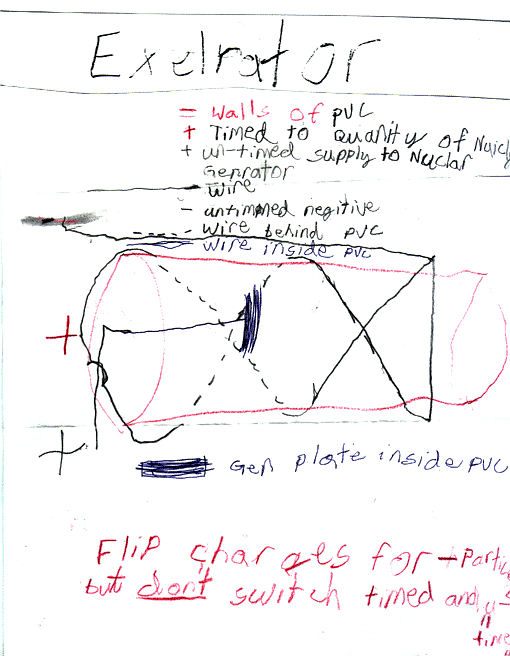Inquiring Minds
|
|
|
New Accelerator Concept Dear Fermi Lab, My name is Riley (Buddy) Martin Cumberland. I'm writing to say I've thought of a way to accelerate subatomic particles that have a charge to about the speed of light without a lot of electricity. I'm 10 years old but when I was 9, I thought of this. My birthday is NOV. 7, 1987 just for my id.
(signed)
Dear Riley (Buddy) Martin Cumberland, This is Dr. G. William Foster, a physicist on the staff of Fermi National Accelerator Laboratory. I got my Ph.D. from Harvard University in 1984 and have been working for Fermi Lab, building experiments and particle accelerators ever since. I was delighted to see someone of your age working on a problem as tough as the one in your letter. Did you really come up this idea when you were nine? As far as I can tell you have many of the aspects figured out right, and (not too surprisingly) there are some engineering problems to solve before you get a working device! One of the first things that you got right is that you need to have charged particles to really accelerate them. Except for electric (and magnetic) fields, there isn't any other good "handle" to grab on to subatomic particles with. For example, if you tried to use gravity to accelerate particles by dropping them out of the window of a building, they would accelerate alright but they would only be going fifty or sixty miles an hour (mph) when they hit the ground. [Actually when we get serious in physics, we usually use the metric system so I would be telling you that they would be going 100 kilometers per hour when they hit the ground... so when they make you study the metric system in school, PAY ATTENTION!] There are other ways to grab onto particles, called the Strong Nuclear Force and Weak Nuclear Force. The problem with these forces is they tend to rip the particles apart (or absorb them) instead of just accelerate them. So, as you correctly figured out, we are basically stuck with electric and magnetic fields. Another thing that you have figured out is that you have to get the timing right of the electric fields, and that you have to reverse the electric fields if you are going to switch between positive particles (like protons) and negative particles (like antiprotons or electrons). Actually, there is a trick that we use around here which is to use an electric field which reverses back and forth really fast. Then when the electric field can go positive then the protons go by to get accelerated, and then it goes negative when it is time for the antiprotons to go by to get accelerated. This way, we can use the same electric fields to accelerate BOTH protons and antiprotons in the same machine! (Did you know that Fermilab has the worlds biggest "Antiproton Source" which is used to manufacture antimatter for high energy physics experiments?). Now let's talk about some of the problems, the first problem is a "dumb" problem, and is easy to fix. The pipe that you have is a PVC pipe (PVC stands for Poly Vinyl Chloride) and is basically a good engineering plastic for most purposes. The problem with using it as the pipe for particles to travel down (high energy phyicists call this the "Beam Pipe") is that you have to pump out all the air so that the subatomic particles don't hit the air. You have to do a really good job of this... for example, the storage ring that we store our antimatter in has to have a better vacuum than the moon! Now, the problem with using PVC for the beam pipe is that when you try to pump it down, atoms of PVC and other stuff keep jumping off the surface of the pipe and puking up the vacuum. So, we gotta use glass or aluminum or stainless steel usually. However, I love the idea of figuring out ways to make high energy accelerators cheaper... maybe we could try putting a thin metal coating on the inside of the PVC pipe and come up with something cheap that still does the job? Keep me posted on your ideas. The second problem that I worry about with your idea is that the electrical voltage to get the particle moving near the speed of light will get to be so big that it will spark (like lightning!) instead of accelerating the particle. People have tried some things that are not too different than your design and they often have found problems with things sparking. One trick that we use at Fermilab is to use magnets. The magnets don't accelerate the particles, but they do bend the particles around in a circle. Then, each time the particles go around, we use an electric field (similar to your design) to tap the particles forward and make them go a little faster. Then the particles go faster and faster as they go around in circles ... over a million times around the ring, the particles can get millions of times more energy, and you only need the one dinky, little, electric field! Do you think that your idea could be adapted to this? Well, anyway, I really appreciate your letter, and feel free to write me back again. If your school (or your house) has a connection to the Internet, you can learn all about Fermilab at the Web site: http://www.fnal.gov. In case it doesn't, I've enclosed some information about Fermilab and its particle accelerators. and KEEP INVENTING!
Dr. G.W. Foster |
| last modified 1/29/1997 physicsquestions@fnal.gov |
FRLsDFx9eyfrPXgV



